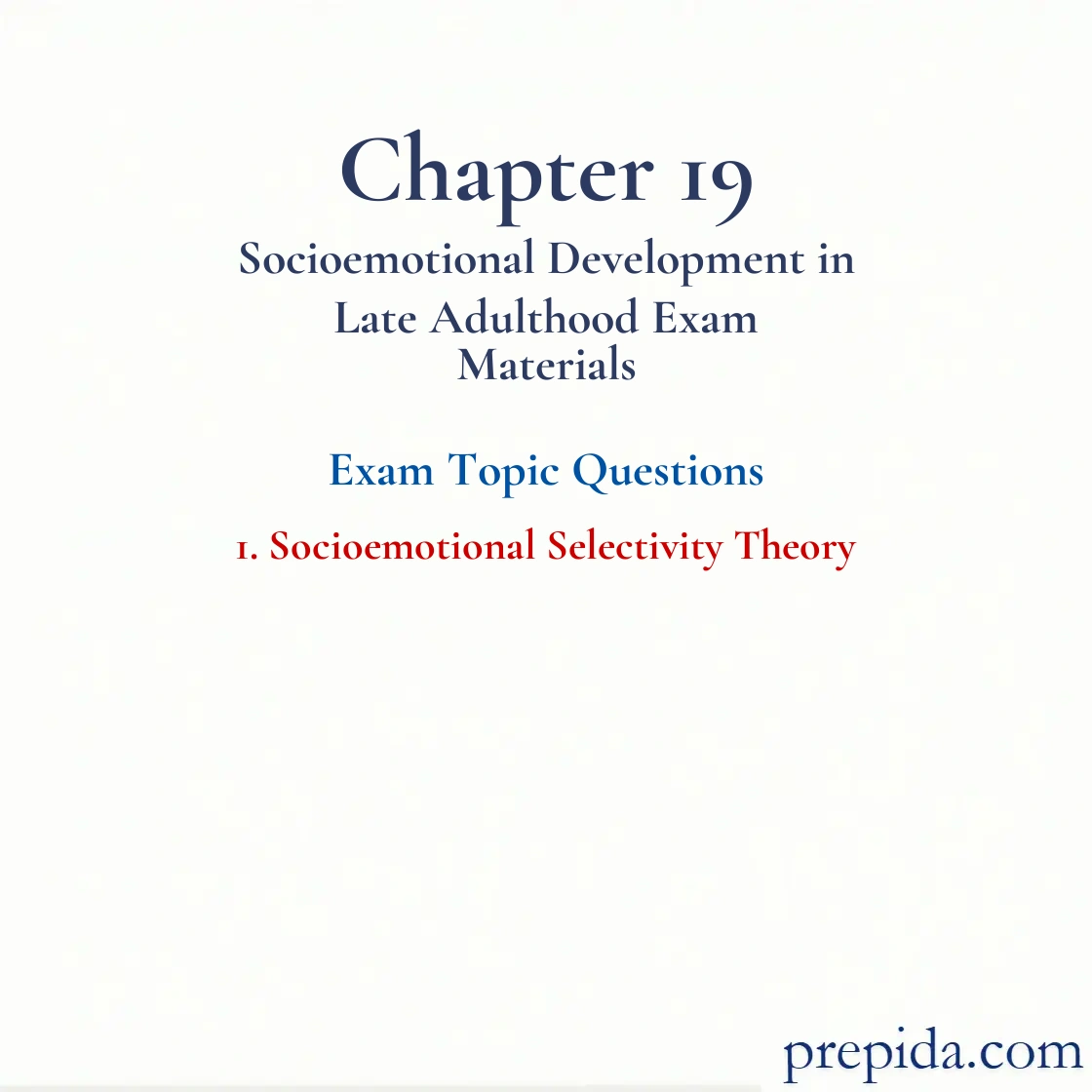
According to socioemotional selectivity theory, which of the following is cited as one of the main reasons for the changing trajectories in knowledge-related and emotion-related goals of older adults compared with younger adults?
- perception of time
- state of health
- self-esteem and self-respect
- social support or the lack of it
Perception: The interpretation of what is sensed.
In the context of socioemotional selectivity theory, which of the following statements is true according to studies on the emotional life of older adults?
- Emotional experiences are less positive in the lives of older adults than in the lives of younger adults.
- Older adults focus less on negative events in their past than younger adults do.
- Older adults show less engagement with highly positive contexts than younger adults.
- Compared with younger adults, older adults react more strongly to negative circumstances.
Socioemotional Selectivity Theory: The theory that older adults become more selective about their social networks. Because they place a high value on emotional satisfaction, older adults often spend more time with familiar individuals with whom they have had rewarding relationships.
According to socioemotional selectivity theory, when time is perceived as ________, as it is when individuals are younger, people are more strongly motivated to pursue information, even at the cost of emotional satisfaction.
- fluid
- limited
- open-ended
- created, not given
Socioemotional Selectivity Theory: The theory that older adults become more selective about their social networks. Because they place a high value on emotional satisfaction, older adults often spend more time with familiar individuals with whom they have had rewarding relationships.
According to socioemotional selectivity theory, when does the emotional trajectory increase?
- in adolescence
- in early adulthood
- in middle childhood
- in late adulthood
Middle Adulthood: The developmental period that begins at approximately 40 to 45 years of age and extends to about 60 to 65 years of age.
According to socioemotional selectivity theory, which of the following is true of the trajectory of motivation for knowledge-related goals?
- It declines during middle and late adulthood.
- It starts in adolescence.
- It peaks in early childhood.
- It is relatively low in the early years of life.
Socioemotional Selectivity Theory: The theory that older adults become more selective about their social networks. Because they place a high value on emotional satisfaction, older adults often spend more time with familiar individuals with whom they have had rewarding relationships.
According to socioemotional selectivity theory, the trajectory of motivation for knowledge-related goals peaks in
- middle and late adulthood.
- adolescence and early adulthood.
- early childhood.
- infancy.
________ theory focuses on the types of goals that individuals are motivated to achieve as they approach the end of life.
- Selective optimization with compensation
- Activity
- Socioemotional selectivity
- Disengagement
Which of the following theories challenges the stereotype that older adults are in despair because of social isolation?
- socioemotional selectivity theory
- activity theory
- disengagement theory
- social breakdown theory
According to the socioemotional selectivity theory, which of the following is true of the emotion trajectory?
- It increases during early adulthood.
- It is low during early childhood.
- It peaks during middle childhood.
- It is high during infancy.
According to socioemotional selectivity theory, individuals are motivated by two types of goals-emotional and
- spiritual.
- practical.
- relational.
- knowledge-related.
According to socioemotional selectivity theory, selective narrowing of social interaction ________ as individuals get older.
- minimizes health-related complications
- minimizes emotional risks
- maximizes social isolation
- maximizes financial freedom
Voletta believes that older adults become more selective about their social networks as they age. She is a proponent of
- socioemotional selectivity theory.
- selective optimization with compensation theory.
- activity theory.
- social discontinuity theory.
Which of the following theories explains why older adults spend most of their time with familiar individuals and family?
- activity theory
- socioemotional selectivity theory
- social discontinuity theory
- disengagement theory
Jeremy is 84 years old. Since the age of 78, Jeremy deliberately reduced contact with his distant relatives and former work colleagues. He now maintains contact only with close family members and friends. In the context of Laura Carstensen's socioemotional selectivity theory, which of the following was most likely the reason for Jeremy's decision to withdraw from social contact?
- He developed negative feelings toward them.
- He suffered from social anxiety disorder.
- He was unable to talk loudly or write clearly.
- He placed a high value on emotional satisfaction.
Which of the following is true of socioemotional selectivity theory?
- It was proposed by Paul Baltes and his colleagues.
- It emphasizes that the trajectory of motivation for knowledge-related goals declines in adolescence and early adulthood and then peaks during middle and late adulthood.
- It challenges the stereotype that the majority of older adults are in emotional despair because of their social isolation.
- It states that adults become less selective about their social networks as they grow older.
Now that Benita is in late adulthood, socioemotional selectivity theory predicts that she will
- become more socially withdrawn as she prepares for death.
- continue to actively make new friends.
- spend most of her time with familiar friends.
- emotionally invest in peripheral relationships.
Joaquin believes that older adults deliberately withdraw from social contact with individuals who are peripheral to their lives while maintaining or increasing contact with close friends and family members with whom they have had enjoyable relationships. He is a proponent of
- activity theory.
- selective optimization with compensation theory.
- socioemotional selectivity theory.
- social discontinuity theory.